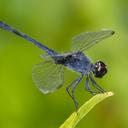United States and Canada
This is a small, common, primarily coastal species. Young males and fema les have a pale face with broad black stripes. The thorax is pale yellowish, heavily striped with black on the front and sides. The dark stripes are broadly confluent at their lower ends. The face and thorax quickly become entirely dark blue or black in males and nearly so in females. The top of the frons becomes metallic blue. The wings are clear or have a hint of amber basally and at the nodus in females. The legs are black. The abdomen is largely black with broad orange or yellow spots dorsally on segments 1-7. These spots quickly become obscured in males and more slowly in females. Females are variable during this transition time; the thorax turns black before the abdomen in some individuals and there may or may not be an amber spot near the nodus in each wing. Females have a triangular shaped, scooped-out, ovipositor projecting ventrally from segment 9.
Size: Total length: 28-35 mm; abdomen: 15-23 mm; hindwing: 18-26 mm.
Similar Species (south-central US): Other similar dragonflies will generally not be found so closely tied to coastal areas. Gray-waisted Skimmer (Cannaphila insularis) is larger and the hindwing bases are narrow. Similar pondhawks (Erythemis) have the basal abdominal segments distinctly swollen. Female small pennants (Celithemis) will lack ovipositors and males with a dark spot in the basal area of the hindwing will also have a different lateral thoracic color pattern.
Habitat: Salt marshes, estuaries, bays and occasionally inland lakes high in salinity.
Natural History: Seaside Dragonlet is the closest thing we have to a marine dragonfly in North America, capable of breeding in waters with high salt concentrations. It is limited to salt marshes and estuaries along the coast and certain inland saline lakes. They may be locally abundant perched in great numbers on bushes, stems or on the ground. Populations of males are often found defending relatively small territories around isolated pools. The female lays eggs accompanied by the male in these pools by dipping her abdomen numerous times while hovering in place. This species probably occurs year around in the southern limits of the region.
Distribution: Atlantic Coast from southern Canada to Texas and New Mexico; West Indies and Central America south to Venezuela and Trinidad.
Source: Abbott, J.C. 2006-2010. OdonataCentral: An online resource for the distribution and identification of Odonata. Available at OdonataCentral.
Edited by Drew Weber (9/24/2015).
